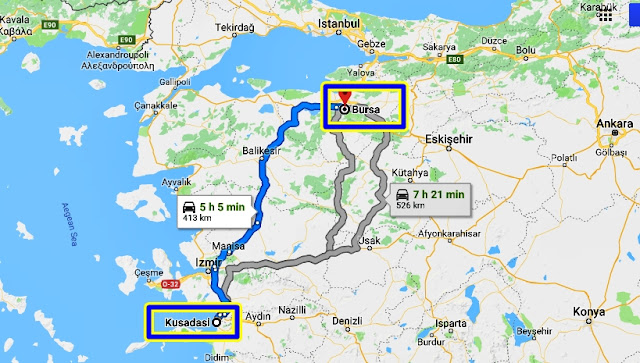Hj Zulheimy Maamor
28 April 2024
This morning, the group left from Bursa to Kusadasi, which is located approximately 413 km away.
KUSADASI
Kusadasi is a resort town located on the Aegean Coast of Turkey. Tourism is the city's primary industry. The name Kusadasi comes from the words 'Kus' (bird) and 'ada' (island).
During the Byzantine Roman Empire, it was known as Ephesus Neopolis, and later it was known as Scala Nova.
Kusadasi is a center of art and culture, as evidenced by its earliest historical records.
LECO LEATHER AND FURThe group was taken on a visit to Leco Leather and Fur, located in Selcuk/Izmir, Turkey, a famous leather goods store in Turkey.
THE CITY OF EPHESUS
Ephesus Archaeological Museum is located in Selcuk / Izmir, Turkey. Ephesus was once a large city in Asia Minor, located on the west coast of Anatolia.
The city is famous for being the location of the
Temple of Artemis,
one of the Seven Wonders of the Ancient World. The Temple of Artemis is an ancient Greek civilization temple built for the god Artemis. This temple was built in 550 B.C. The city was demolished in 401 BC but was rebuilt before it was largely destroyed by an earthquake. The city is estimated to have been inhabited since 6,000 BC.
The Temple of Hadrian, one of the structures still preserved in Ephesus, was built in 138 AD to commemorate the visit of the Roman
Emperor Hadrian (117 - 138 AD).
Emperor Hadrian is among "The Five Good Emperors," which refers to the five Roman Emperors namely Nerva, Trajan, Hadrian, Antonius Pius, and Marcus Aurelius.
Ephesus in mentioned in the Bible, according to Christian faith, it is a city where the apostle Paul preached and it is the subject of the Book of Ephesians. It is also said to have been the place where Mary, mother of Jesus lived in her final years.
I'm lucky I don't live during this era...what if I have a stomach ache?
After the Ephesus City tour, the group was taken to visit Gozbasi Lokum, a shop that sells Turkish Delight.
PAMUKKALE, TURKIYE
After the visit to Gozbasi Lokum, the group left for Pamukkale, a city in Western Turkey known for its thermal waters that are rich in minerals and flow directly down the nearby hillside. The travel distance from Kusadasi to Pamukkale is 201 km and takes approximately 2 hours and 54 minutes. Pamukkale is renowned for its historical relics and natural beauty. The name Pamukkale originates from a Turkish word that means "Cotton Castle". The ancient city of Hierapolis is located nearby and is home to the UNESCO World Heritage Site of Pamukkale.

ANTIQUE CITY OF HIERAPOLIS
Upon arrival in Pamukkale, the group was taken to visit the Antique City of Hierapolis.
The Antique City of Hierapolis was historically founded by Eumenes II, King of Pergamon who ruled from 197 - 159 BC. The name of the city comes from the name of Hiera, the wife of Telephus (daughter of Hercules and grandson of Zeus).
Hierapolis was handed over to the Roman Empire in 133 BC, but it was destroyed by an earthquake in 60 AD during the reign of Emperor Nero.
COTTON CASTLE
From Hierapolis, the group was then taken to visit the Cotton Castle, which is a terrace of white hot water pools on the hillside.
Pamukkale meaning "Cotton Castle" in Turkish, is a natural site in Denzil Province in Southwestern Turkey. This area is famous for a carbonate mineral left by the flowing of thermal spring water. It is located in Turkey's Inner Aegean region, in the River Menderes valley.
PAM THERMAL HOTELThe group stayed at PAM Thermal Hotel during their stay in Pamukkale, located at 120, Saglik Sokak 5/1, Pamukkale / Denizli, Turkiye.
NEXT:
Hj Zulheimy Maamor
Lembah Keramat, KL
30.4.2024: 8.59 p.m

.jpg)
.png)

.png)
.jpg)
.jpg)
.png)
.jpg)
.png)

.jpg)
.jpg)
.png)
.jpg)
.jpg)
.jpg)
.jpg)
.png)
.jpg)
.jpg)
.jpg)
.png)
.jpg)
.jpg)
.jpg)
.jpg)

.jpg)
.jpg)
.png)
.png)
.png)

.png)
.png)
.png)
.jpg)
.jpg)
.jpg)
.jpg)

.jpg)

.png)
.png)

.jpg)
.jpg)
.jpg)
.jpg)
.jpg)
.jpg)
.jpg)
.jpg)


.jpg)
.jpg)
.jpg)
.jpg)
.jpg)
.jpg)
.jpg)
.jpg)
%20A.jpg)
.jpg)
.JPG)
.jpg)
.jpg)
.JPG)
.JPG)
.jpg)
.jpg)
.jpg)
.jpg)
.jpg)
.jpg)
.jpg)
.jpg)


.jpg)
.jpg)
.png)
.png)
.jpg)


.jpg)
.jpg)
.jpg)
.jpg)
.jpg)
.jpg)
.jpg)
.jpg)
A.jpg)
.jpg)
.jpg)

.jpg)
.jpg)
.jpg)
.jpg)
.jpg)
.jpg)

.jpg)
.jpg)
.jpg)
.png)
.jpg)